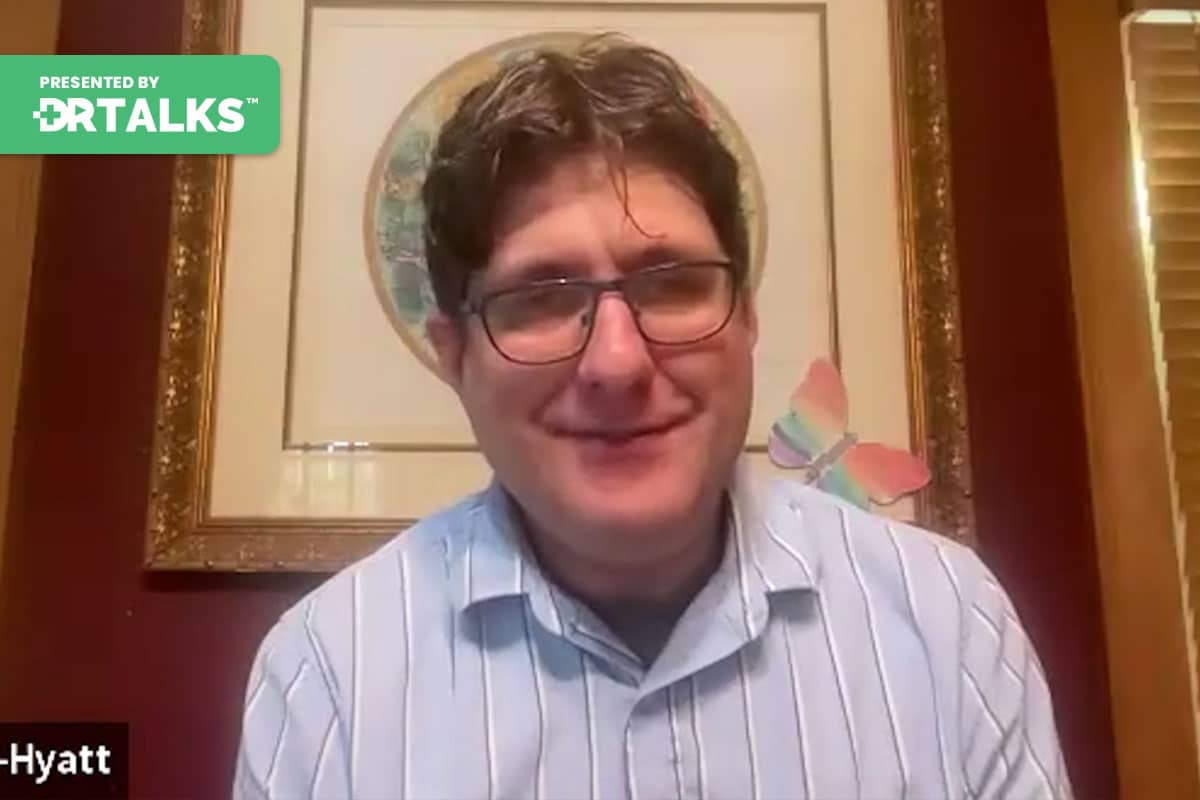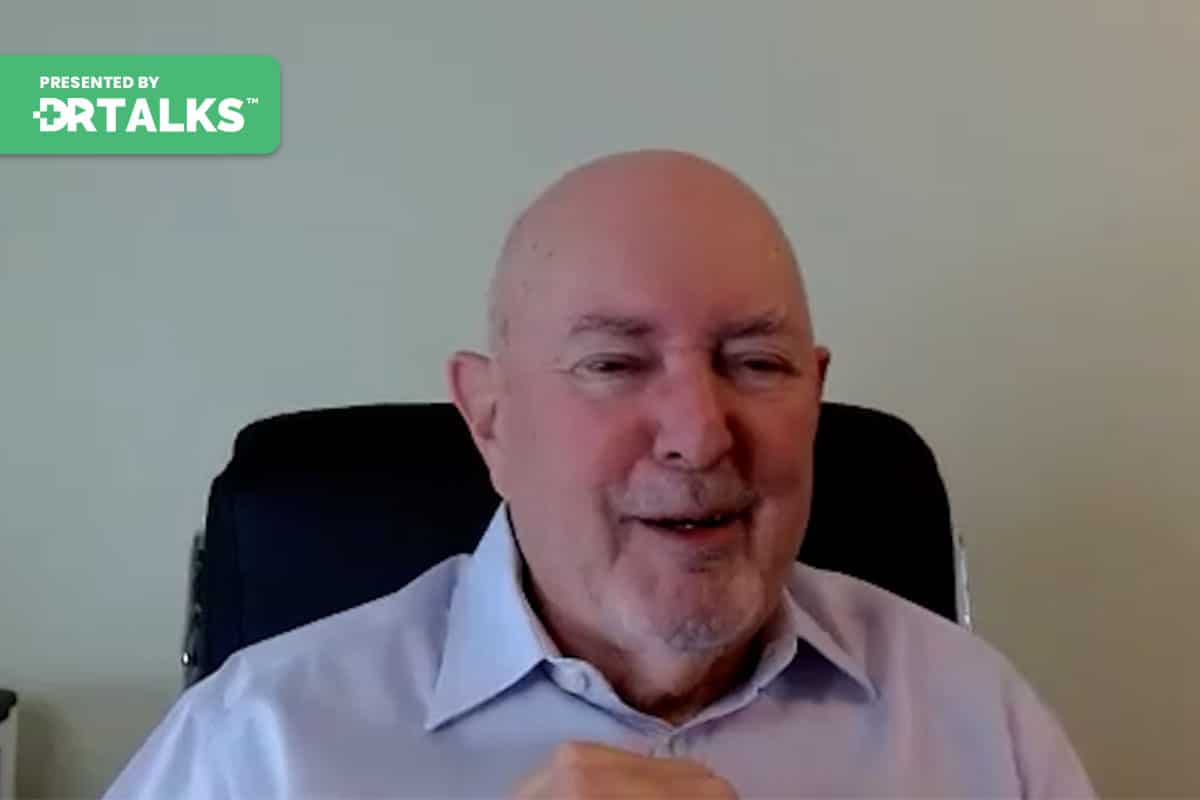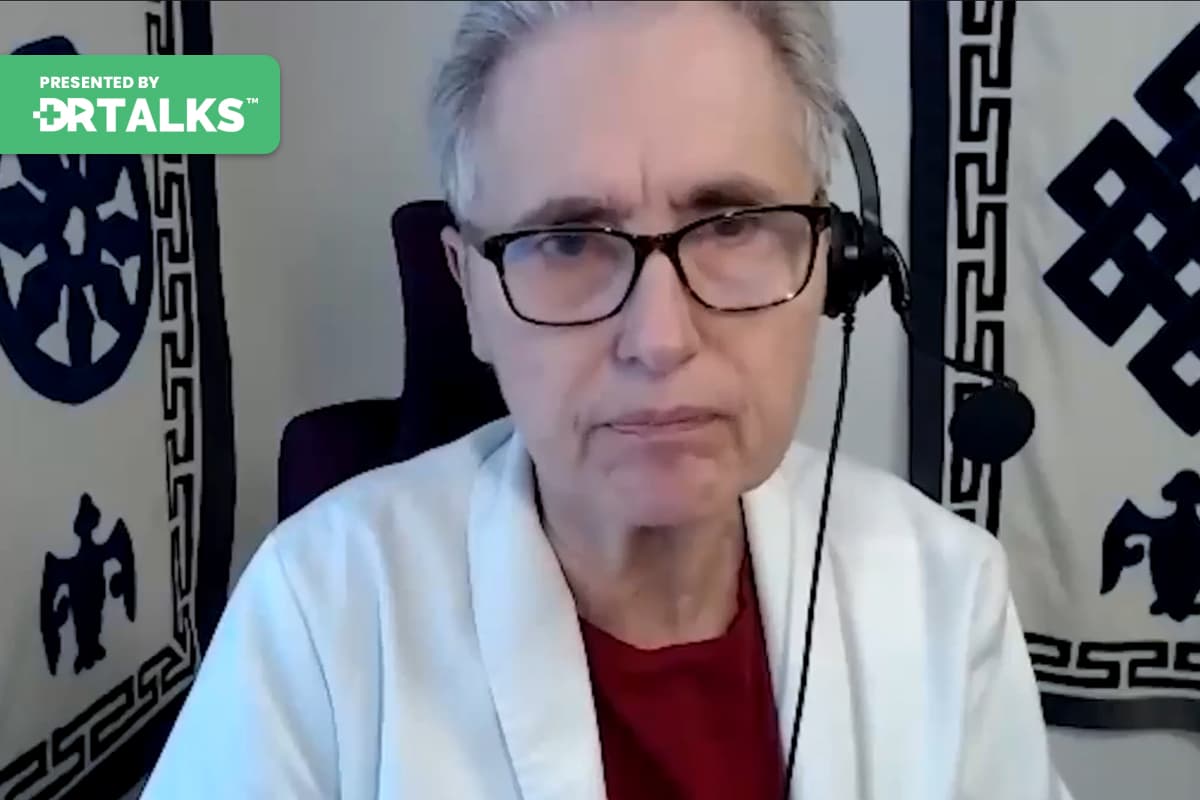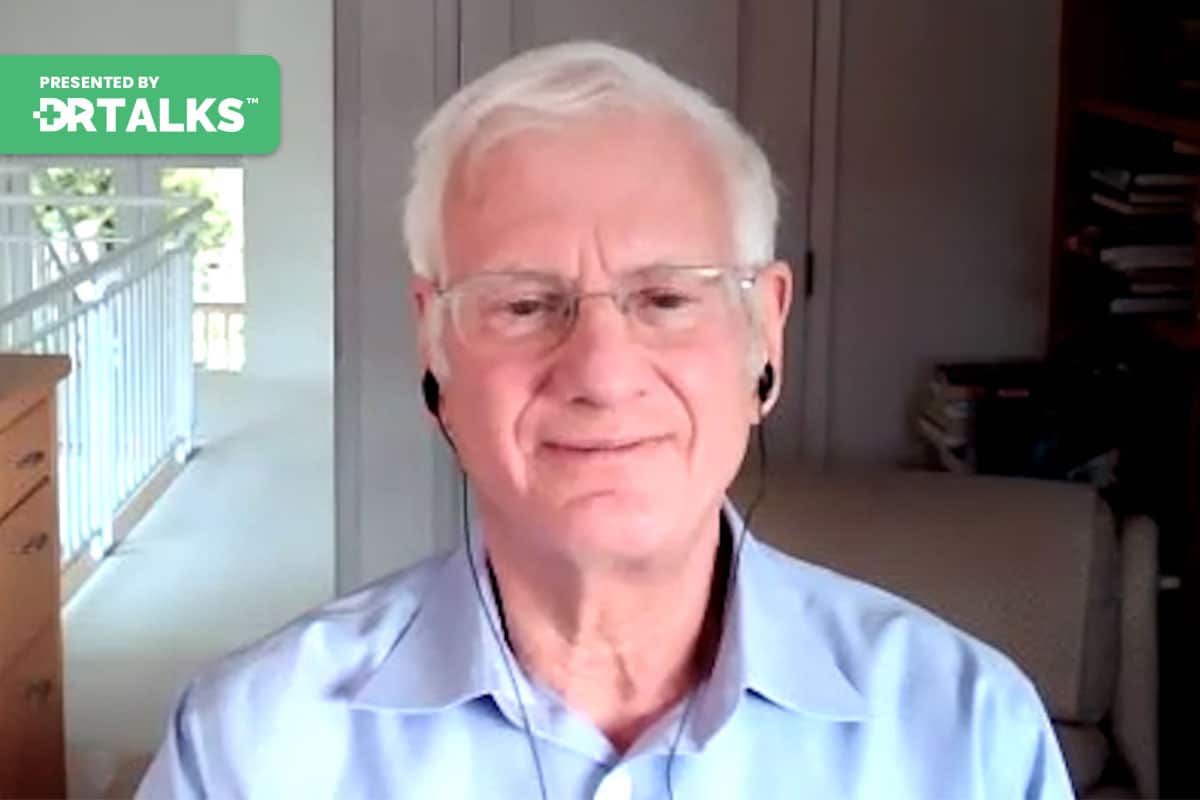Join the discussion below

Dr. Heather Sandison is the founder of Solcere Health Clinic and Marama, the first residential care facility for the elderly of its kind. At Solcere, Dr. Sandison and her team of doctors and health coaches focus primarily on supporting patients looking to optimize cognitive function, prevent mental decline, and reverse... Read More

Dr. Matt Pratt-Hyatt received his PhD in cellular and molecular biology from the University of Michigan. He has over a dozen publications in well-known research journals such as PNAS and Cell Metabolism. He is focused on assisting with diagnosis and treatment of mitochondrial disorders, neurological diseases, chronic immune diseases, and... Read More
Dr. Matt Pratt-Hyatt explains the risks of mold and mycotoxins in your home
- Understand the difference between mold and mycotoxins
- Learn how to know if mold is in your home, how to test for it, and what to do about it
Heather Sandison, ND
Welcome to this episode of the Reverse Alzheimer’s Summit. I’m your host, Dr. Heather Sandison. I’m excited to introduce you to my friend Dr. Matt Pratt-Hyatt. He received his Ph.D. in cellular and molecular biology from the University of Michigan, and he is focused on assisting with the diagnosis and treatment of mitochondrial disorders, neurological diseases, chronic immune diseases, and more. He specializes in developing tools that examine factors at the interface between genetics and toxicology. His work is bringing new insight into how genetics and toxicants interact and how that interaction can lead to mental health disorders, chronic health issues, and metabolism disorders, including Alzheimer’s. Thanks so much for joining us, Matt.
Matt Pratt-Hyatt, PhD
Well, I’m going to be here really excited.
Heather Sandison, ND
So you and I know each other because you have worked at some of your work at some of the labs that I use regularly with my patients. And I really want our audience to understand kind of these pieces that are really confusing for a lot of people around what is mold, what is a micro toxin, and what does it matter if I’m worried about my cognition? So would you just start by defining a mold versus a micro toxin?
Matt Pratt-Hyatt, PhD
Yeah, that is a great question. I hear that one a lot. And nobody should be, like, worried about whether or not they are confused because even some of the smartest people I know are like, okay, what’s the difference? Okay, so mold is the living organisms, like the cells that are most of our, you know, like present out in the environment or present in our homes or present in our bodies at times. So they are living organisms. They are they are. But all of them need some type to emit a certain amount of humidity to live off of. And they need a food source to live. It is something that is going to be sugary, some type of like like was the term of like carbohydrates in it. And then they produce drywall. Drywall. Having drywall has lots of carbs in it, very starchy. So then they are like when they are like living through this, they, they give off bypass products. And these byproducts are mostly to attack bacteria that are attacking them. But it also attacks like other bigger organisms such as ourselves which could be like messing with them. So these are the mycotoxins. These are like kind of like biological warfare between the mold and us.
Heather Sandison, ND
Okay.
Matt Pratt-Hyatt, PhD
And these are small molecules. These are like a thousand times smaller than the molds themselves. So they can move around our home a lot more freely than the molds do.
Heather Sandison, ND
And they are not visible either. And they do not have a smell, typically where mold has a smell. Mycotoxins. So there is also some confusion about this word. MYCO refers to molds or fungus, and MICRO is also very small, they are micro, micro toxins.
Matt Pratt-Hyatt, PhD
That is correct. Yeah. So I mean, people that study like mold and bacteria or like micro microbiologists, but somebody that could just study mold of funguses themselves, that could be a mycologist. So it is very similar but slightly different things.
Heather Sandison, ND
Okay, so these are toxins that are inert. They are not alive. They do not replicate. They are very, very small. And when they get into our bodies, they like you said, it is like warfare. These are the toxins that the microbes mold is what we are talking about here in particular that they use to basically fight back when we try to kill them. And so how does this work in our bodies? What does it cause? What does it do?
Matt Pratt-Hyatt, PhD
So sort of partly depends on which myco toxin you have in your body. Some of them do different things. A large majority of them do something that we are like talking about today of like affecting the nervous system and affecting the myelin sheaths and the nerves. And in the brain, it is decreasing white matter. In the brain, it is causing inflammation. It is attacking a lot of them like to attack the powerhouses of our cells to mitochondria. So they are causing like mitochondrial damage and mitochondrial inflammation. When a cell gets attacked, it is mitochondria start becoming unhealthy. It releases a lot of like cytokines into the system. And these cytokines can have other effects throughout the body that causes further inflammation. But then besides that, they attack so many other things, attack the thalamus, they attack the thyroid. They attack the gut. They attack the immune system. My message.
Heather Sandison, ND
Basically, if you have got it, they attack it.
Matt Pratt-Hyatt, PhD
I mean, they are. But that is the problem, is that they are attacked as different from one person to another because of genetics and which particular mycotoxins are being affected by. So the symptoms can be somewhat different from person to person. So sometimes it is hard for people to, like, realize that they are being attacked.
Heather Sandison, ND
So this speaks to why a lot of conventional doctors are not familiar with this. Right. This is part of what is going on when you go into your conventional doctor and say, hey, I have brain fog or I have this or that going on, I have got diarrhea. And they do not think of mycotoxins or mold toxicity being part of the problem. Most conventional doctors are looking for an allergy to mold. And yet, because these toxins can affect so many different organ systems, they can manifest, right? They interact like you are an expert in our genetics and manifest in very different ways. And so identifying this as the cause is a bit challenging.
Matt Pratt-Hyatt, PhD
And you are exactly right and they like to mimic so many other things like are saying like they are having gut pains, diarrhea. They are having. Yeah, they are like brain fog or like motor motor skill issues, which is kind of like, okay, well, they like the doctor because like all you are an early stage Parkinson’s or you are having gut issues from like Candida are clostridia And those some of those things might be true, but it is really like the molds that are like the mold toxins that really like at the base of everything cause they are knocking down the immune system, allowing candida and Clostridia to occur or causing cellular damage that is causing like Parkinson’s like symptoms to occur. So unfortunately, a lot of times when I’m talking to a practitioner, they are talking to me like a client they have been trying to treat for like a year or two and have really like problems. Like the things I normally do to try to do that work are working on this patient.
Heather Sandison, ND
So I have to admit, I made the mistake for a while of asking patients if they would be exposed to a water-damaged building, either at work or at school, or at home. If they knew that there was a leak or if they had been, they knew they were exposed to mold. And if they said, no, I would not run the test. And then a year later, exactly what you are describing, they are not getting better. The things they usually do are not working. And so I go back to my drawing board and go, okay, let us just test for my good toxins and see if maybe you did not know you were exposed. And sure enough, they pop up, and sometimes egregiously so.
So there is kind of this classic I know somebody’s toilet above me in the apartment above me flooded and there is a bunch of mold in my house and I can see it or there was a storm that came through and there was either a flood in the basement or through the leak. And it is very clear there is mushrooms growing. And so there was mold. And then there is kind of the more insidious, like a small leak behind the refrigerator or the dryer isn’t venting correctly and you never notice the moisture or the mold. But there is a significant amount growing either on the back of the drywall or in another spot that isn’t totally apparent to everyone. And so it is really challenging to find. How would you recommend that patients navigate that?
Matt Pratt-Hyatt, PhD
It is a great question and it really like comes to like trying to identify the symptoms. Like, are you not like are you like getting fatigued or you are like a brain fog occurring? That is like trying to like to say like, well, were first identify like, okay, maybe I should do this urine micro toxin test. Okay, that comes back positive. Well, where can I begin exposed? I mean, that is the reason why we have our environmental micro toxin test, which looks for like mold or mold and micro toxins in the home that could come up positive. Because is that, like you said, it is not always like water damage in a lot of homes. The AC just isn’t quite working properly. So it is keeping the house cool enough, but it is not lowering the humidity. So when it gets above 55 and you can start getting more like mold, everybody has mold in their homes, but it is like one spore here, two spores there. It is forming like hundreds of spores.
During my sabbatical of working in the environment, like moving out of the clinical and into the environment for a year and a half, I did dozens of inspections of homes. I can not tell you how many times we like to come into our home and realize it is like you find it in the like the rafters of either the attic or in the basement, as it is like rolling along this like some like boards that you really wouldn’t like even like notice. But then it gets like then that that mold that produces micro toxins that get pulled into the AC unit and then this could spread throughout the whole house. So I mean, that is the bigger issue here, but it could just be like one issue it in a small part of the House that is it is getting disseminated throughout the whole house.
Heather Sandison, ND
Yeah. This is a really scary thing and often sort of they are these impossible decisions to make. I saw a patient yesterday as a couple, in fact, and they have I mean, here in San Diego, they have this beautiful home right near the ocean. And they are in an apartment. And so that was actually who I was just referring to. They had a neighbor above them who had a toilet leak and it dripped into their apartment and, you know, it was repaired. But his I think his MOCA score has remained stable, but they both do not feel like they are doing as well, kind of generally speaking. And his wife, who’s caring for him, she’s more irritable, she’s less patient, she’s not sleeping as well. Her gut’s upset. Her mood is dysregulated. And this is all kind of happened in the last six months. And she’s chalking it up to caring for her husband, who has, you know, moderate dementia and which is stressful in and of itself. But when I saw his tests, his mycotoxins had been cruising or all along, they were elevated, but his okra toxin was about 1.8, maybe hit to ones and now it is at 17.
Matt Pratt-Hyatt, PhD
Oh, my.
Heather Sandison, ND
This was a radical jump. And so I, I said to them, you know, your options are like weird. This is a miracle that he’s doing as well as he is. And your options are to get out of that house and get it remediated or just sell it. You know, this is not probably worth it from my medical perspective, you know, a real estate agent might tell you something different. But from my medical perspective, for their brain and for their bodies, the best thing to do is to get out of that environment.
Matt Pratt-Hyatt, PhD
Definitely. I mean. Yeah, and if you care. Yes. People like that heartbreak for them because sometimes they can not afford to move out of those situations. And it can be I mean, you are like looking at like somewhere between like a 5000 and $20,000 remediation for something like that because probably there is an in that space between the apartment above theirs and theirs is probably like thousands of mold spores and that in that space between the two apartments and they are got that like whole like ceiling pathway needs to come down or it is hard to say. I mean, that is what inspectors are for and they have like good tools for deciphering those things. But yeah, I mean, that is rough.
Heather Sandison, ND
It is so hard. And when you are caring for someone with dementia, the thought of moving, even if it is just for a couple of weeks to an Airbnb or a motel or a hotel or whatever it is that can be so disorienting for people and so stressful.
Matt Pratt-Hyatt, PhD
Yeah.
Heather Sandison, ND
And negatively the questions come up of, well, what about my couch that is in that room that had the leak in the ceiling? And what about my clothes that have been in that room? And do I have to have the artifact cleaned or do I have to have it replaced? Like, how far did this spread and how vigilant do I need to be?
Matt Pratt-Hyatt, PhD
Yeah, those are all great questions and there is several different mold remediate areas out there that have really proven like techniques to get rid of not just the mold but the mycotoxins as well. So it is really important when you talk to your inspector or remediate or like get their game, like get the whole game planned out to say like, okay, how are you going to treat the mold? What are you going to do for the Mycotoxins? Because that is why we produce test for both of them, not just measuring the mold, but the mycotoxins as well. Because one thing that I worry about is when I’m working with a practitioner that has a client that they like, okay, well, we ripped out all the mole, like all the mold out of the bathroom, but then we like do the micro-targeting test later. They are still like a whole bunch of mycotoxins on the like the furniture and the air ducts, wherever it is at. So you’ve got like make sure that whoever you are working with is willing to, like, okay, well, we are going to do our post-test with the mycotoxins, not just the mold spores because some will do like, okay, ah, we will do the remediation, but when the air tests are blowing this number of spores, we are going to consider you good. And you got to like you can not just be you can not like hire your expectations for them.
Heather Sandison, ND
Got it. And so there is there is quite a spectrum of mediators. And I want to also say you are in real-time labs. So for anybody who’s interested in getting these tests done for their homes or for themselves, you can get the testing done in real-time. And I have learned to trust real-time over the past eight or nine years that I have been working with them. They have been very consistent and the results reflect my patient’s experience, which I feel like is the most telling thing. When those mycotoxins are up, people have symptoms and when they come down their urinary mycotoxins I often see people getting much, much, much better. And so getting that testing done, I think is very, very helpful.
Now, when you go to work with a mediator, there is a spectrum, right? You have your mediators and your construction contractors that maybe are working more for like a landlord type situation where they just want to fix it or for insurance and they just want to get it fixed, kind of doing the minimum. And then on the other end of the spectrum, there is maybe the person that is going to charge you as much as they possibly can and do as much work as possible so that they can just rack up that bill. Yeah, and what we are really looking for is that contractor, a mediator who enters, stands this link between the health of your home and the health of your body and is going to be thorough but not do things that are not necessary. So how do we find that type of person?
Matt Pratt-Hyatt, PhD
But we do have a finder on our website to try to like help. Now, we do not completely vet that finder. So adult-like view like everybody on there as somebody that we like are like encouraging you to use.
Heather Sandison, ND
Your own due diligence, you are going to.
Matt Pratt-Hyatt, PhD
Do your due diligence. But these are people that are least like looking at mycotoxins. So they really start like have taken that next step. They are not just like, okay, I’m going to look at spores and I’m not going to like to worry about Mycotoxins at all.
Heather Sandison, ND
So they have some familiarity with this concept that it is not just about the mold and the spores, but it is also about the toxins they produced while they were there.
Matt Pratt-Hyatt, PhD
Yeah. So that we have done that, my due diligence now I can not say like whether or not they are, their inspections are as thorough as they should be or if are they charging what we would consider are an appropriate amount. I can not say any of that. But I mean, if somebody is really like egregious, we will like I mean, if anybody’s like comes across one of these, please send us a note and we will try to we will work on removing.
Heather Sandison, ND
But what a phenomenal service. I mean, just having a place to start is sometimes the hardest part because it can feel so overwhelming. And when people are living in these environments, that is part of it, right, is brain fog and fatigue. And so every the thought of going through this process can feel really overwhelming. And just having a bit of guidance on the first steps is really, really helpful. So thank you for making that available.
Matt Pratt-Hyatt, PhD
As I would just do all I can.
Heather Sandison, ND
Better. So then tell me a little bit more about how the testing is done. So what do you recommend? There is this whole question around provocation. What do you guys recommend to practitioners for offering these tests?
Matt Pratt-Hyatt, PhD
So this is my personal belief. This is about speaking in real times on this. But so like Neal, Nathan and I did a study probably about four years ago where we like had like a group that was propagated and another one as on propagated and we like say like, okay, well what kind of provocation works best that we, we found was like 250 milligrams of glutathione for five days. And I do it like a Sara a hot bath exercise on their fifth day and then collecting on the morning of the six seem to like work the best now there are some patients when they start taking Lewis I own a source mobilized the toxins and they start being like really symptomatic.
We usually like tell those patients to like just like drop out a study this collector their urine at the next morning because usually that will work I mean we get enough mobilization from those patients and that excretion that we can get good values from those patients. So that is what Dr. Nathan and I have like worked on. And it seems like the I think that talking to lots of practitioners, it seems like work well for them. So that is, that is generally until I have more data, what I recommend.
Heather Sandison, ND
Is, okay, great, that is really helpful and that can be oral liposomal good again.
Matt Pratt-Hyatt, PhD
Yeah. No. Yeah. And I do not have a lot people will ask all what brand and I do not really have like a particular brand that I like recommend. But yeah, I mean, an oral glutathione often seems to work pretty well.
Heather Sandison, ND
Okay. Yeah. And we have I have just been doing I have glutathione pushes or oral if somebody and can not make it to my clinic I have been doing I have got it they own patches of two grams for years and so that that is a bigger dose quicker we have people collect for 6 hours after that purge typically and I think I’m just so used to looking at those results and that I haven’t changed my ways yet.
Matt Pratt-Hyatt, PhD
I mean, if it works for you, I do not. I would not like I said, I wouldn’t say like because then like that is you are like used to seeing those results. So if you change that, then you might get like a different like result pattern and I do not know, it’ll take you a while to.
Heather Sandison, ND
To adjust and especially for patients that I have had, you know, I have been having them do them every 12 weeks for months on end, that it would definitely shift to what I would expect to see. So that is another point I think that is really good to make. And I do tell patients that particularly if they can not make it or they can not tolerate glutathione, I just tell them, do what you did last time so that we can understand if as long as you tolerate it, like let’s find a consistent way that we can provoke you. That is not going to trigger you too much. Or as soon as you get triggered, as soon as you feel that increase in symptoms, go ahead and stop, like you said, and then collect that first morning more concentrated urine to send off to the lab. Does that feel like reasonable?
Matt Pratt-Hyatt, PhD
The only caveat I would put to that is like if there are on a binder, I generally recommend that going after binder for 72 hours prior to collection because those binders they are like made to like drive the micro toxins into the stool. So if they are going to if it is getting driven to the stool, it is getting driven away from the urine. So we want to like make sure that that mobilized toxins are going through the urine pathway and that is the stool pathway.
Heather Sandison, ND
Got it. That is a really great caveat and really, really important to understand. So basically we can get rid of Mycotoxins to the urine and through stool. And this is part of why we often binders are part of this as Corella Clear Colostomy and Zola Charcoal. These types of binders are there. I think of them like a catcher’s mitt to grab that bile where the mycotoxins are being excreted by the liver into the stool. Now if we push them all that way through the binding, then in the gut, then they are not going to be coming out in the urine where we are testing the micro toxin levels and we got it. Want to get a correct accurate reflection of the body burden of Mycotoxins. So we would have you stop for three days before collecting urine? Stop the binders.
Matt Pratt-Hyatt, PhD
Exactly. Yeah. I mean, that is what seems like the work well for us. I mean, 72 hours seems to work generally for most patients well enough that we can get a good value from them.
Heather Sandison, ND
Got it. That is really helpful. And then there is this blue line on their real time results. And I love looking at the graphs. And as I mentioned, I tend to test my patients every 12 weeks until they normalize, until all of them are below that blue line. So tell me how you came up with that blue line and why it is really thick sometimes and why it is really thin other times?
Matt Pratt-Hyatt, PhD
I think it depends on how zoomed in it is to the bigger graph. So you have like a lot of variation, like where you like like let’s say you write your patient is 18 and now they are down to like point seven. Their blue line is going to be smaller because you are on the graph too. Zoomed out a lot more when you are like have like less variation. You’re like kind of like bouncing back and forth right above and below the blue line. It could be a lot thicker. So that is really the only difference between the thickness of it.
Heather Sandison, ND
And so that blue line represents kind of that equivocal zone rate where people below that typically do not have symptoms and people above that typically do have symptoms. And if you are in that blue line or right on that blue line, you are kind of in that equivocal spot where this may be significant and it might not be. Is that right?
Matt Pratt-Hyatt, PhD
That is exactly right. And I mean, so this was before my time at real time. But yeah, this was developed about ten years ago of like yeah. Looking at like healthy individual sales people that have more toxins. What is kind of like where is like the, the baseline for that and kind of like looking at us testing of like I have looked at like the last like 8000 patients we have had and those blue lives really like kind of like match up what we consider as like the 50th percentile of that. We didn’t plan this, but this like systematically kind of like falls along the, what I consider the fifth percentile of all of our patients.
Heather Sandison, ND
So got it. I see. So this is based on lots and lots and lots of data.
Matt Pratt-Hyatt, PhD
Yes.
Heather Sandison, ND
On all the labs that are coming in to you and getting Brennan. Got it. This is really helpful. Okay, so what should a patient do if they are listening? If they haven’t seen me as a doctor, maybe they do not even have access to a functional medicine or a bredeson trained doctor. How can they learn more about getting real time labs done and maybe even finding a doctor who understands how to interpret it and order it for them?
Matt Pratt-Hyatt, PhD
Yeah, so two things. In a 26 states, you do not need a doctor to order the test. You could order at what’s called a direct access testing so you can go straight to our website and order the test. If you are in one of those 26 states. If not, then you can like go to our also go to our website and go to under the patient tab and find a practitioner. And a lot of our practitioners are working ever since COVID. I mean, one of the, one of the few good things about COVID is it is kind of like gave like a more motivation for a lot of practitioners to really open up their practices for doing telemedicine. So we have a lot of practitioners definitely like moved into doing telemedicine into as a part of their practice.
Heather Sandison, ND
So it really increased access.
Matt Pratt-Hyatt, PhD
Yes.
Heather Sandison, ND
Got it. And so if somebody orders this directly, well, also I want to mention that this is often covered by Medicare and is from. Yeah. Which makes it much more accessible as well. So does this need to be ordered through a provider to be covered by Medicare?
Matt Pratt-Hyatt, PhD
That is true, yes. If you are trying to get it covered by Medicare, it has to be ordered by a Pecos patient or a practitioner who has a Pecos number. So somebody that has been vetted through Medicare.
Heather Sandison, ND
Got it. Got it. So they need to be able to they might not necessarily take Medicare for the visits, but it is possible to find doctors often functional medicine, Dios and MDs will have a Pecos number and be able to order labs, get them covered by Medicare, even though they do not accept Medicare for their visits. So finding that type of doctor can make this really accessible and affordable for you. And then also you can get those repeat labs done, which is so important to track your progress and to know when you are finished, you get to this is one of my favorite things about environmental medicine is that we figure it out. We do the detective work, we get you the right treatment, and then we come to a finish line. And as long as you are not re-exposed, we do not have to worry about that toxin causing wreaking havoc in your brain anymore.
Matt Pratt-Hyatt, PhD
Exactly. And I love those times. I just love talking that they are like patients or practitioners, that themselves are patients at conferences and they are like, okay, well, yeah, I was like sick. I was like homebound. I could not like get out of my bed. And now they are like this so active and so, like, full of life. It is. I love hearing those stories.
Heather Sandison, ND
Yeah. Back to feeling like themselves again. Yes. I had a patient a not that long ago who had a very, very high micro toxin level and he had the highest levels I’d ever seen. Is Oka toxin. Was it over 20? His glial toxin was in the teens. I mean, they were all very, very high as Aflatoxins were like 12 or something. I mean, every single one of them was essentially the highest I’d ever seen. The good news with him was he was willing to do all the work. He was willing to do the right thing on IVs. He was willing to get out of the moldy environment. He was willing to take the binders and the liver support and sweat and do the breath work.
He was willing to do it all and those numbers came down really quickly. So he started at a MOCA score of 20 and he got up to a 26 and just six months. So that was an incredible turnaround. His daughter was moving to help him out and she moved anyways and he didn’t need the help and he ended up helping her out with her kids. And so it really just changed the trajectory of the relationships and this family to have him get those mycotoxins out of his system and get healthy again.
Matt Pratt-Hyatt, PhD
That is great. Now I love those type of stories. That is how and why I do what I do.
Heather Sandison, ND
It is so inspiring and so much fun. So Matt, tell us again, where can we get more information about real time where you give them the Web address and more information about your work?
Matt Pratt-Hyatt, PhD
Well, yeah. So, I mean, our website is Real Time Wired.com. You can come in and you can like sign up to be part of our on our mail mailing list. So we send out a monthly newsletter that talks about all of our upcoming webinars that are occurring, which we generally do like a webinar every month. And then the talk that you can like find out like early about like our new test, we have like several new tests. They are coming out throughout the year.
Heather Sandison, ND
Would you remind me what those are? Because those are exciting.
Matt Pratt-Hyatt, PhD
Oh, well, I mean, I can guess so. We just came out with glyphosate this month and now we have an organic acid profile and environmental pollutant profile that is going to be coming out. So very excited about our new test. Then we have got several other ones that’ll be coming out in the second half of the year.
Heather Sandison, ND
Fantastic. So glyphosate is a roundup that is the active ingredient in Roundup. And if you are curious about that and how it might affect you, jump on over to Dr. Isaac. Elias is talk because we talk there about his specific binder for glyphosate. And so this is a really great kind of marriage. The complement of being able to have the test that shows you your glyphosate number and then again being able to watch that number drop as you identify your exposures and eliminate them and then take those binders that are specific to the toxin to quicken that process. And then you get to do that happy dance when the labs show that you are no longer in that highly elevated range. Glyphosate is another one of these toxins that is directly neurotoxic.
And I often will see patients, you know, the more severe Alzheimer’s patients, ALS, Parkinson’s patients who have very elevated glyphosate levels. And we do not always know where they are coming from. Sometimes it is an indication that maybe they are not genetically, again, your expertize, but genetically, maybe they are predisposed to hanging on to that glyphosate. So they are not necessarily exposed more than most people are more than normal, but they just do not do a very good job getting rid of it. Can you speak at all to that really?
Matt Pratt-Hyatt, PhD
I mean, that is a great question. And if you look in the lecture, really not a lot there to speak of it. So I wish I could get I wish I could provide more information. I love I mean, that is my favorite thing to do about this job is providing information. But yeah, there is really not much there that we do not know about how the body really interacts with glyphosate.
Heather Sandison, ND
Yeah, it is challenging when and quite sad, right? We have seen people who are exposed to high amounts of it how it can really change their their health. But great to know that you guys are offering that testing. And actually, Stephanie CnF also has a talk on this on the summit and she speaks at length about glyphosate and kind of the mechanisms and biochemistry of that. So you can head on over to that one as well.
Matt Pratt-Hyatt, PhD
I’m glad that more and more people are coming out and speaking out about the importance of monitoring not just our environment but our own bodies for these type of things.
Heather Sandison, ND
And exactly. Yeah, it really gives us a lot of and my hope of this talk is that it is empowering, right? It gives us that power to take back our how to make the decisions it to have the information so that we can make good, well informed decisions about how to optimize cell function and then our health generally.
Matt Pratt-Hyatt, PhD
Yeah. The other thing that you said is like all what about my job is like, well, my job is I work with practitioners to try to like set up research studies to try to figure out how can our test help educate a practitioner on the best course of treatment. So we are trying and trying to figure out what the best course of treatment are for each type of patient case. Because there are for like mycotoxins, there are a lot of different caveats of treatment. You have patients, they have mass cell activation or they have Hashimoto’s or they have gut issues. So we are trying to figure out which protocols work best for different types of patients.
Heather Sandison, ND
Well, for better or worse, you know, there is lots of patients out there that need this help. So I’m glad you are providing the help. And I wish fewer people had to deal with this. But at least if they do, they have good direction coming from you guys. I really appreciate all that you do and making these tests available is just really is one of those tools that is so helpful for me and my practice and has changed the lives of many of my patients. So thank you, Matt.
Matt Pratt-Hyatt, PhD
We are so happy to be here to help people. I mean, obviously, we would be happy to do something else, but it seems we are doing what seems to be needed.
Heather Sandison, ND
Well, thank you. And thank you also for your time and for joining us today and explaining some of these really confusing concepts and what we can do about more to make a toxin.
Matt Pratt-Hyatt, PhD
Oh, happy to be here. Thank you for having me.
Downloads










